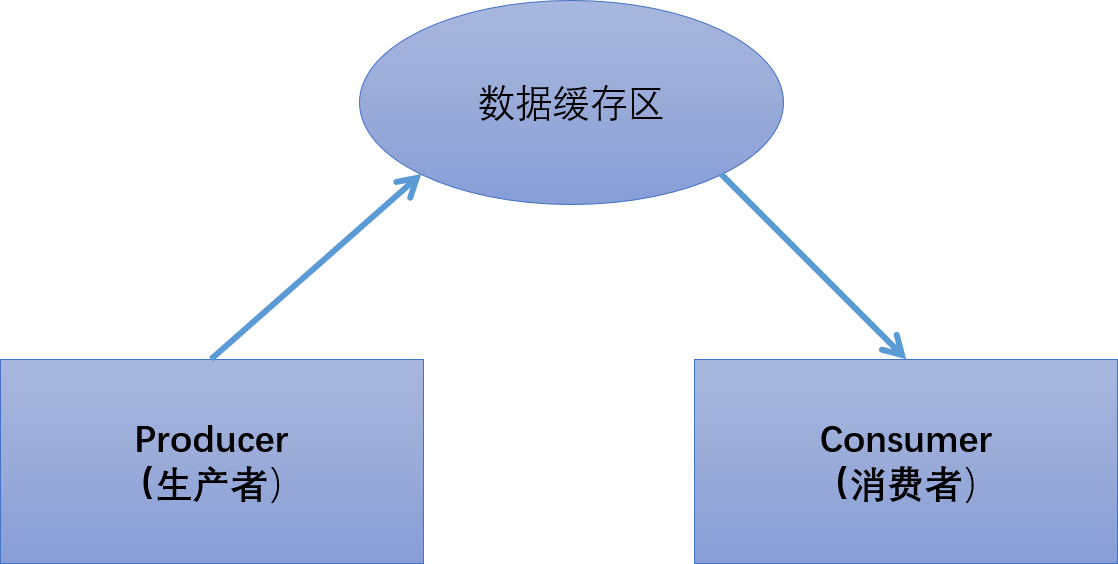多线程之间通信及线程池
线程通信
-
应用场景:生产者和消费者问题
- 假设仓库中只能存放一件产品,生产者将生产出来的产品放入仓库,消费者将仓库中产品取走消费
- 如果仓库中没有产品,则生产者将产品放入仓库,否则停止生产并等待,直到仓库中的产品被消费者取走为止
- 如果仓库中放有产品,则消费者可以将产品取走消费,否则停止消费并等待,直到仓库中再次放入产品为止
-
这是一个线程同步问题,生产者和消费者共享同一个资源,并且生产者和消费者之间相互依赖,互为条件。
- 对于生产者,没有生产产品之前,要通知消费者等待。而生产了产品之后,又需要马上通知消费者消费
- 对于消费者,在消费之后,要通知生产者已经结束消费,需要生产新的产品以供消费
- 在生产者消费者问题中,仅有synchronized是不够的
- synchronized可阻止并发更新同一个共享资源,实现了同步
- synchronized不能用来实现不同线程之间的消息传递(通信)
-
解决线程之间通信问题的方法
| 方法名 | 作用 |
|---|---|
| wait() | 表示线程一直等待,知道其他线程通知,与sleep不同,会释放锁 |
| wait(long timeout) | 指定等待的毫秒数 |
| notify() | 唤醒一个处于等待状态的线程 |
| notifyAll() | 唤醒同一个对象上所有调用wait()方法的线程,优先级别高的线程优先调度 |
解决方式1
并发协作模型“生产者/消费者模式”--->管程法
- 生产者:负责生产数据的模块(可能是方法,对象,线程,进程);
- 消费者:负责处理数据的模块(可能是方法,对象,线程,进程);
- 缓冲区:消费者不能直接使用生产者的数据,他们之间有个缓冲区,生产者将生产好的数据放入缓冲区,消费者从缓冲区拿出数据

//测试:生产者消费者模型-->利用缓冲区解决:管程法
//生产者,消费者,产品,缓冲区
public class TestPC {
public static void main(String[] args) {
SynContainer container = new SynContainer();
new Productor(container).start();
new Consumer(container).start();
}
}
//生产者
class Productor extends Thread{
SynContainer container;
public Productor(SynContainer container){
this.container = container;
}
//生产
@Override
public void run() {
for (int i = 0; i < 100; i++) {
container.push(new Chicken(i));
System.out.println("生产了"+i+"只鸡");
}
}
}
//消费者
class Consumer extends Thread{
SynContainer container;
public Consumer(SynContainer container){
this.container = container;
}
//消费
@Override
public void run() {
for (int i = 0; i < 100; i++) {
System.out.println("消费了-->"+container.pop().id+"只鸡");
}
}
}
//产品
class Chicken{
int id;//产品编号
public Chicken(int id) {
this.id = id;
}
}
//缓冲区
class SynContainer{
//需要一个容器大小
Chicken[] chickens = new Chicken[10];
//容器计数器
int count = 0;
//生产者放入产品
public synchronized void push(Chicken chicken){
//如果容器满了,就需要等待消费者消费
if (count==chickens.length){
//通知消费者消费,生产者等待
try {
this.wait();
} catch (InterruptedException e) {
e.printStackTrace();
}
}
//如果没有满,我们就需要丢入产品
chickens[count] = chicken;
count++;
//可以通知消费者消费了
this.notifyAll();
}
//消费者消费产品
public synchronized Chicken pop(){
//判断能否消费
if (count==0){
//等待生产者生产,消费者等待
try {
this.wait();
} catch (InterruptedException e) {
e.printStackTrace();
}
}
//如果可以消费
count--;
Chicken chicken = chickens[count];
//吃完了,通知生产者生产
this.notifyAll();
return chicken;
}
}
解决方式2
- 并发协作模式“生产者/消费者模式”--->信号灯法
//测试生产者消费者问题2:信号灯法,标志位解决
public class TestPC2 {
public static void main(String[] args) {
TV tv = new TV();
new Player(tv).start();
new Watcher(tv).start();
}
}
//生产者-->演员
class Player extends Thread{
TV tv;
public Player(TV tv){
this.tv = tv;
}
@Override
public void run() {
for (int i = 0; i < 20; i++) {
if (i%2==0){
this.tv.play("快乐大本营播放中");
}else {
this.tv.play("抖音:记录美好生活");
}
}
}
}
//消费者-->观众
class Watcher extends Thread{
TV tv;
public Watcher(TV tv){
this.tv = tv;
}
@Override
public void run() {
for (int i = 0; i < 20; i++) {
tv.watch();
}
}
}
//产品-->节目
class TV{
//演员表演,观众等待
//观众观看,演员等待
String voice;//表演的节目
boolean flag = true;
//表演
public synchronized void play(String voice){
if (!flag){
try {
this.wait();
} catch (InterruptedException e) {
e.printStackTrace();
}
}
System.out.println("演员表演了:"+voice);
//通知观众观看
this.notifyAll();//通知唤醒
this.voice = voice;
this.flag = !this.flag;
}
//观看
public synchronized void watch(){
if (flag){
try {
this.wait();
} catch (InterruptedException e) {
e.printStackTrace();
}
}
System.out.println("观看了:"+voice);
//通知演员表演
this.notifyAll();
this.flag = !this.flag;
}
}
线程池
使用线程池
- 背景:经常创建和销毁、使用量特别大的资源,比如并发情况下的线程,对性能影响很大。
- 思路:提前创建好多个线程,放入线程池中,使用时直接获取,使用完放回池中。可以避免频繁创建销毁、实现重复利用。类似生活中的公共交通工具。
- 好处:
- 提高响应速度(减少了创建新线程的时间)
- 降低资源消耗(重复利用线程池中线程,不需要每次都创建)
- 便于线程管理(...)
- corePoolSize:核心池的大小
- maximumPoolSize:最大线程数
- keepAliveTime:线程没有任务时最多保持多长时间后会终止
- JDK5.0起提供了线程池相关API:ExexutorService和Executors
- ExecutorService:真正的线程池接口。常见子类ThreadPoolExecutor
- void execute(Runnable command):执行任务/命令,没有返回值,一般用来执行Runnable
Future submit(Callable task):执行任务,有返回值,一般又来执行Callable - void shutdown():关闭连接池
- Executors:工具类、线程池的工厂类,用于创建并返回不同类型的线程池
import java.util.concurrent.ExecutorService;
import java.util.concurrent.Executors;
//测试线程池
public class TestPool {
public static void main(String[] args) {
//1.创建服务,创建线程池
//newFixedThreadPool 参数为:线程池大小
ExecutorService service = Executors.newFixedThreadPool(10);
//执行
service.execute(new MyThread());
service.execute(new MyThread());
service.execute(new MyThread());
service.execute(new MyThread());
//2.关闭链接
service.shutdown();
}
}
class MyThread implements Runnable{
@Override
public void run() {
System.out.println(Thread.currentThread().getName());
}
}
作者:wangyudong
本文版权归作者和博客园共有,欢迎转载,但必须给出原文链接,并保留此段声明,否则保留追究法律责任的权利。



